Corporate and Financial Accounting: Funding and Reporting Analysis
VerifiedAdded on 2022/10/14
|16
|3371
|434
Report
AI Summary
This report provides a comparative analysis of the funding sources utilized by Telstra Corporation and TPG Telecom Ltd., two prominent Australian telecommunication and technology firms, examining their annual reports from 2016, 2017, and 2018. The report delves into the components of owner's equity, including share capital, reserves, retained profits, equity available to shareholders, and non-controlling interests, alongside an analysis of movements within these accounts. Furthermore, it investigates the liabilities of both companies, categorizing them into current and non-current liabilities, and scrutinizing items such as trade payables, employee benefits, other provisions, borrowings, derivative financial liabilities, and current tax payables, with an assessment of their respective movements over the specified period. The core focus is on identifying the primary sources of funding employed by both firms, with a discussion of the advantages of using borrowings. The report also examines the concepts of small proprietary companies, large property companies, and reporting entities, and concludes with a discussion on the implications of reporting requirements in Australia.
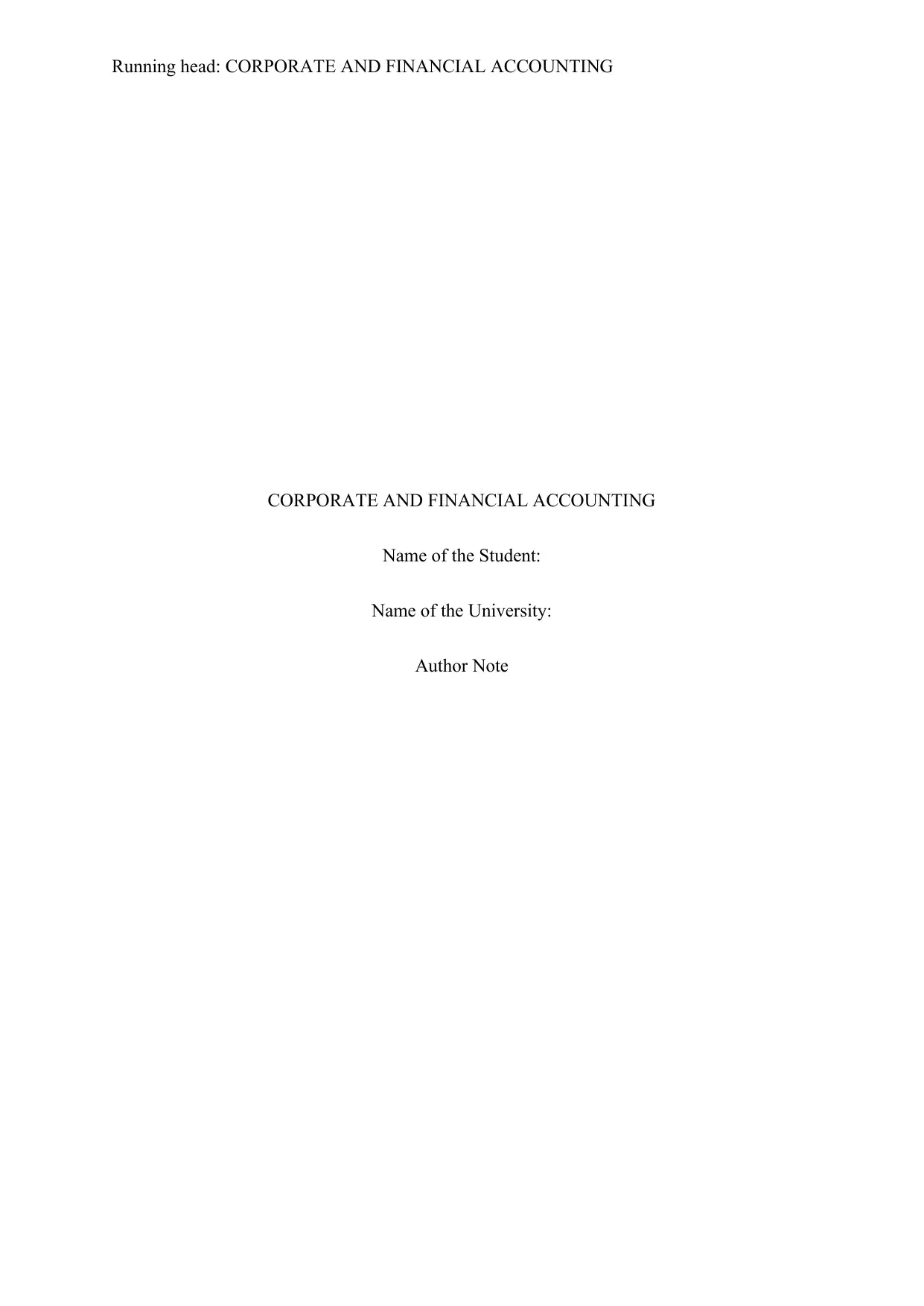
Running head: CORPORATE AND FINANCIAL ACCOUNTING
CORPORATE AND FINANCIAL ACCOUNTING
Name of the Student:
Name of the University:
Author Note
CORPORATE AND FINANCIAL ACCOUNTING
Name of the Student:
Name of the University:
Author Note
Paraphrase This Document
Need a fresh take? Get an instant paraphrase of this document with our AI Paraphraser

1CORPORATE AND FINANCIAL ACCOUNTING
Executive Summery
This report is mainly prepared to comparatively analyse the source of funding used by the
two companies from the same industry of Australia. The chosen companies for this report are
the Telstra Corporation and TPG Telecom Ltd. This report analysis the annual report of both
companies for the year 2018, 2017 and 2016 to comparatively analyse the source of funding
used by both the firms. The report also analyse the concept of small proprietary company,
large property company and reporting entities. Lastly, this report discuss about the
implications of the reporting requirements of Australian Council which classifies the
companies as per their reporting requirements.
Executive Summery
This report is mainly prepared to comparatively analyse the source of funding used by the
two companies from the same industry of Australia. The chosen companies for this report are
the Telstra Corporation and TPG Telecom Ltd. This report analysis the annual report of both
companies for the year 2018, 2017 and 2016 to comparatively analyse the source of funding
used by both the firms. The report also analyse the concept of small proprietary company,
large property company and reporting entities. Lastly, this report discuss about the
implications of the reporting requirements of Australian Council which classifies the
companies as per their reporting requirements.
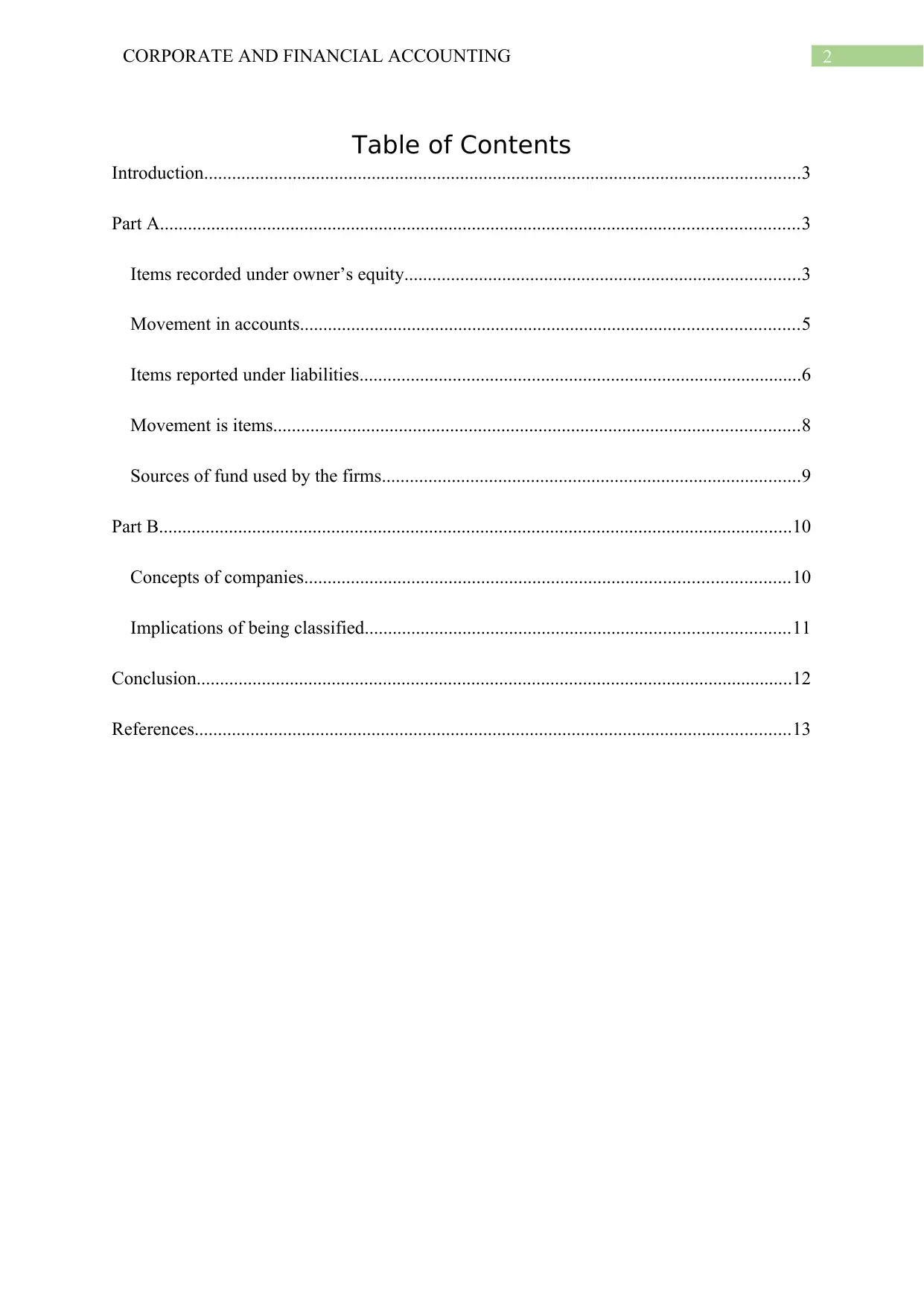
2CORPORATE AND FINANCIAL ACCOUNTING
Table of Contents
Introduction................................................................................................................................3
Part A.........................................................................................................................................3
Items recorded under owner’s equity.....................................................................................3
Movement in accounts...........................................................................................................5
Items reported under liabilities...............................................................................................6
Movement is items.................................................................................................................8
Sources of fund used by the firms..........................................................................................9
Part B........................................................................................................................................10
Concepts of companies........................................................................................................10
Implications of being classified...........................................................................................11
Conclusion................................................................................................................................12
References................................................................................................................................13
Table of Contents
Introduction................................................................................................................................3
Part A.........................................................................................................................................3
Items recorded under owner’s equity.....................................................................................3
Movement in accounts...........................................................................................................5
Items reported under liabilities...............................................................................................6
Movement is items.................................................................................................................8
Sources of fund used by the firms..........................................................................................9
Part B........................................................................................................................................10
Concepts of companies........................................................................................................10
Implications of being classified...........................................................................................11
Conclusion................................................................................................................................12
References................................................................................................................................13
⊘ This is a preview!⊘
Do you want full access?
Subscribe today to unlock all pages.

Trusted by 1+ million students worldwide
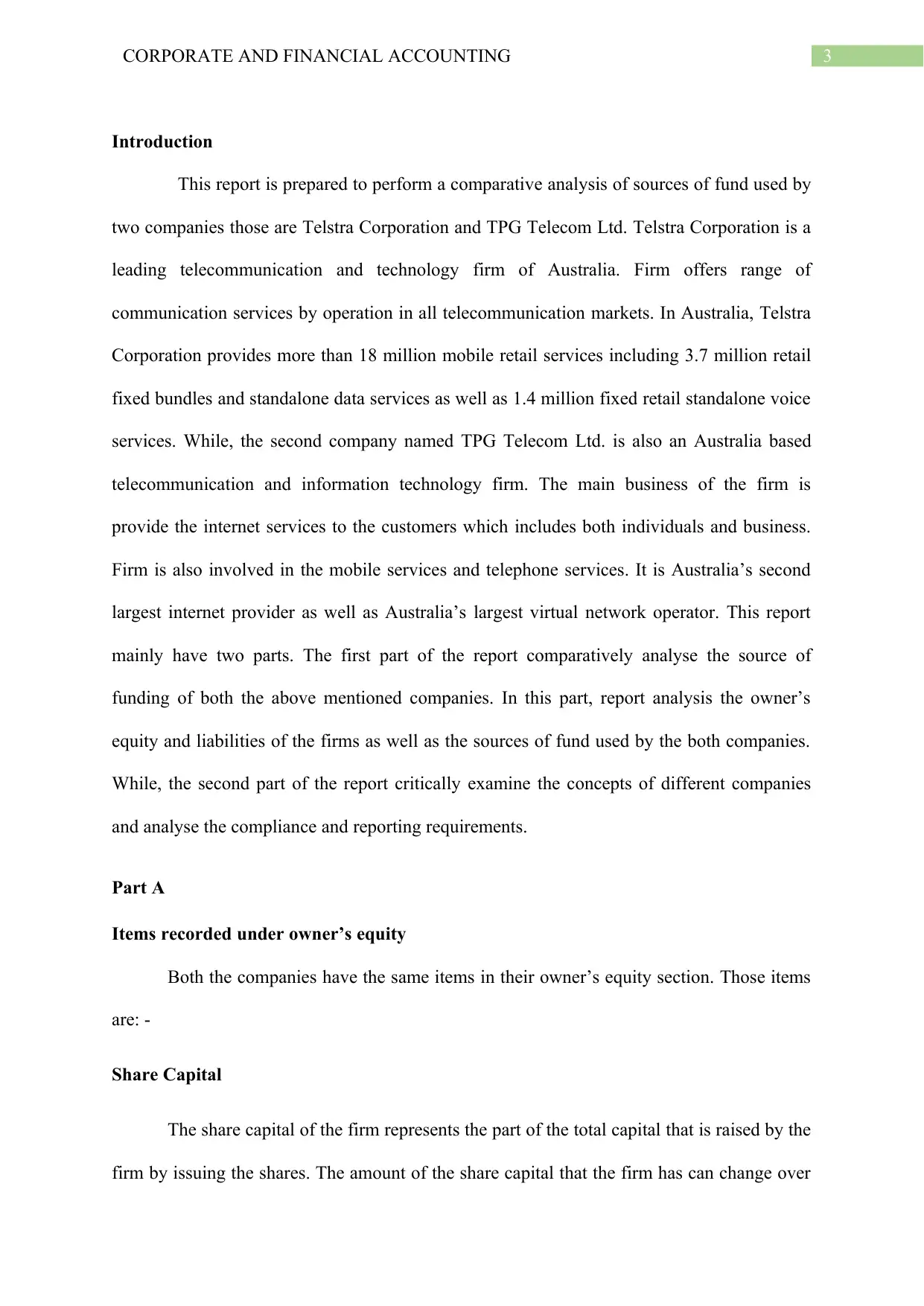
3CORPORATE AND FINANCIAL ACCOUNTING
Introduction
This report is prepared to perform a comparative analysis of sources of fund used by
two companies those are Telstra Corporation and TPG Telecom Ltd. Telstra Corporation is a
leading telecommunication and technology firm of Australia. Firm offers range of
communication services by operation in all telecommunication markets. In Australia, Telstra
Corporation provides more than 18 million mobile retail services including 3.7 million retail
fixed bundles and standalone data services as well as 1.4 million fixed retail standalone voice
services. While, the second company named TPG Telecom Ltd. is also an Australia based
telecommunication and information technology firm. The main business of the firm is
provide the internet services to the customers which includes both individuals and business.
Firm is also involved in the mobile services and telephone services. It is Australia’s second
largest internet provider as well as Australia’s largest virtual network operator. This report
mainly have two parts. The first part of the report comparatively analyse the source of
funding of both the above mentioned companies. In this part, report analysis the owner’s
equity and liabilities of the firms as well as the sources of fund used by the both companies.
While, the second part of the report critically examine the concepts of different companies
and analyse the compliance and reporting requirements.
Part A
Items recorded under owner’s equity
Both the companies have the same items in their owner’s equity section. Those items
are: -
Share Capital
The share capital of the firm represents the part of the total capital that is raised by the
firm by issuing the shares. The amount of the share capital that the firm has can change over
Introduction
This report is prepared to perform a comparative analysis of sources of fund used by
two companies those are Telstra Corporation and TPG Telecom Ltd. Telstra Corporation is a
leading telecommunication and technology firm of Australia. Firm offers range of
communication services by operation in all telecommunication markets. In Australia, Telstra
Corporation provides more than 18 million mobile retail services including 3.7 million retail
fixed bundles and standalone data services as well as 1.4 million fixed retail standalone voice
services. While, the second company named TPG Telecom Ltd. is also an Australia based
telecommunication and information technology firm. The main business of the firm is
provide the internet services to the customers which includes both individuals and business.
Firm is also involved in the mobile services and telephone services. It is Australia’s second
largest internet provider as well as Australia’s largest virtual network operator. This report
mainly have two parts. The first part of the report comparatively analyse the source of
funding of both the above mentioned companies. In this part, report analysis the owner’s
equity and liabilities of the firms as well as the sources of fund used by the both companies.
While, the second part of the report critically examine the concepts of different companies
and analyse the compliance and reporting requirements.
Part A
Items recorded under owner’s equity
Both the companies have the same items in their owner’s equity section. Those items
are: -
Share Capital
The share capital of the firm represents the part of the total capital that is raised by the
firm by issuing the shares. The amount of the share capital that the firm has can change over
Paraphrase This Document
Need a fresh take? Get an instant paraphrase of this document with our AI Paraphraser
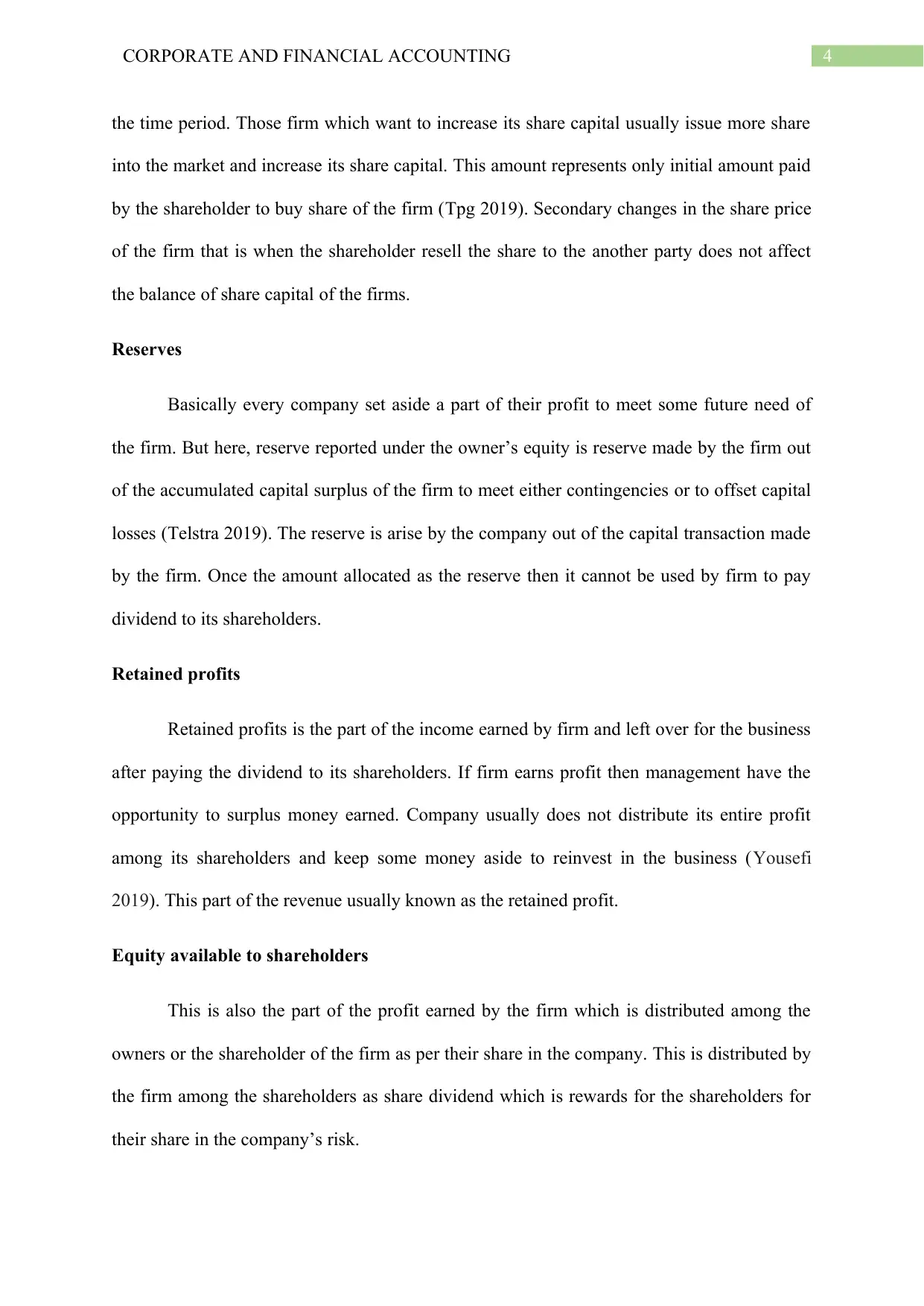
4CORPORATE AND FINANCIAL ACCOUNTING
the time period. Those firm which want to increase its share capital usually issue more share
into the market and increase its share capital. This amount represents only initial amount paid
by the shareholder to buy share of the firm (Tpg 2019). Secondary changes in the share price
of the firm that is when the shareholder resell the share to the another party does not affect
the balance of share capital of the firms.
Reserves
Basically every company set aside a part of their profit to meet some future need of
the firm. But here, reserve reported under the owner’s equity is reserve made by the firm out
of the accumulated capital surplus of the firm to meet either contingencies or to offset capital
losses (Telstra 2019). The reserve is arise by the company out of the capital transaction made
by the firm. Once the amount allocated as the reserve then it cannot be used by firm to pay
dividend to its shareholders.
Retained profits
Retained profits is the part of the income earned by firm and left over for the business
after paying the dividend to its shareholders. If firm earns profit then management have the
opportunity to surplus money earned. Company usually does not distribute its entire profit
among its shareholders and keep some money aside to reinvest in the business (Yousefi
2019). This part of the revenue usually known as the retained profit.
Equity available to shareholders
This is also the part of the profit earned by the firm which is distributed among the
owners or the shareholder of the firm as per their share in the company. This is distributed by
the firm among the shareholders as share dividend which is rewards for the shareholders for
their share in the company’s risk.
the time period. Those firm which want to increase its share capital usually issue more share
into the market and increase its share capital. This amount represents only initial amount paid
by the shareholder to buy share of the firm (Tpg 2019). Secondary changes in the share price
of the firm that is when the shareholder resell the share to the another party does not affect
the balance of share capital of the firms.
Reserves
Basically every company set aside a part of their profit to meet some future need of
the firm. But here, reserve reported under the owner’s equity is reserve made by the firm out
of the accumulated capital surplus of the firm to meet either contingencies or to offset capital
losses (Telstra 2019). The reserve is arise by the company out of the capital transaction made
by the firm. Once the amount allocated as the reserve then it cannot be used by firm to pay
dividend to its shareholders.
Retained profits
Retained profits is the part of the income earned by firm and left over for the business
after paying the dividend to its shareholders. If firm earns profit then management have the
opportunity to surplus money earned. Company usually does not distribute its entire profit
among its shareholders and keep some money aside to reinvest in the business (Yousefi
2019). This part of the revenue usually known as the retained profit.
Equity available to shareholders
This is also the part of the profit earned by the firm which is distributed among the
owners or the shareholder of the firm as per their share in the company. This is distributed by
the firm among the shareholders as share dividend which is rewards for the shareholders for
their share in the company’s risk.
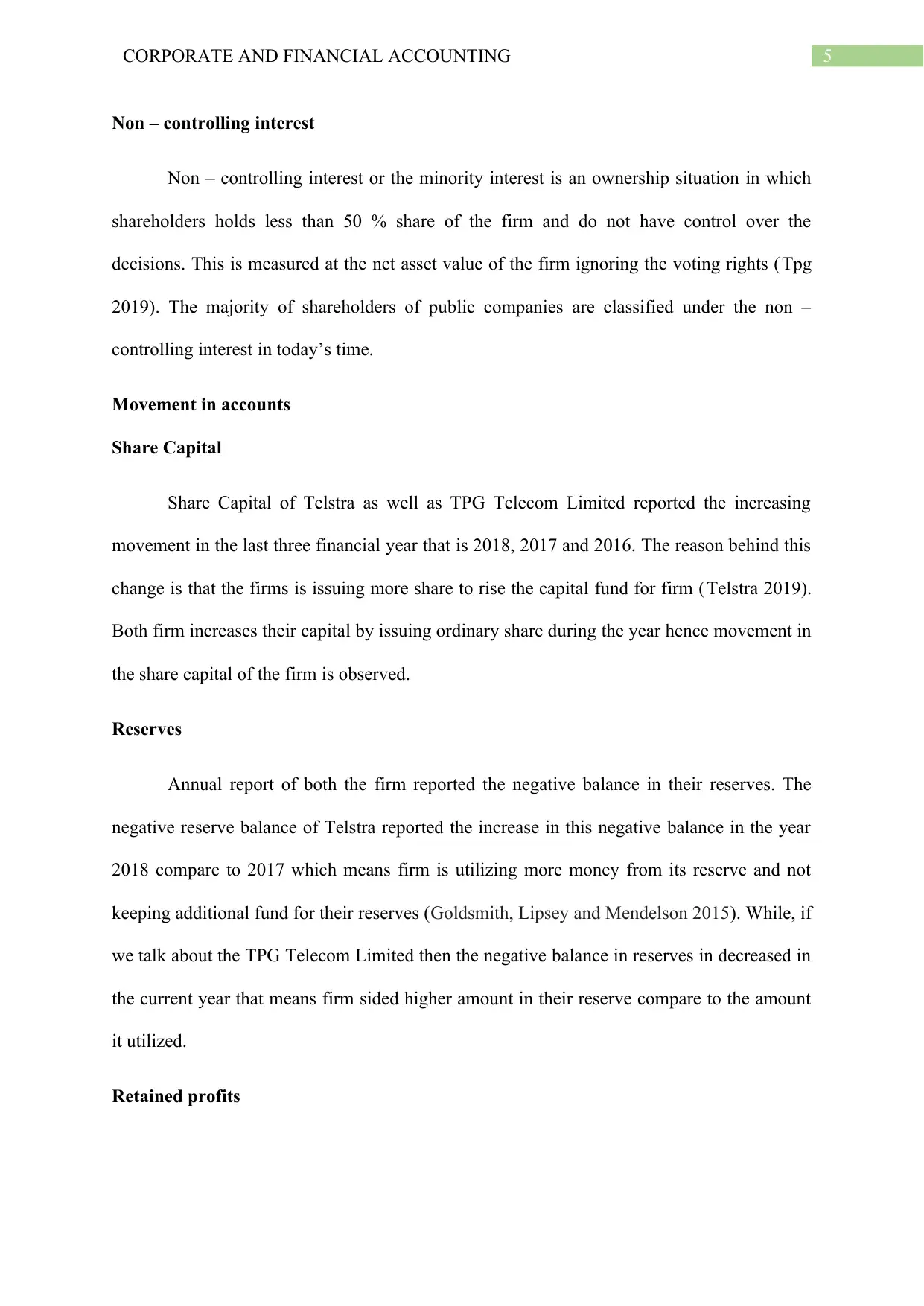
5CORPORATE AND FINANCIAL ACCOUNTING
Non – controlling interest
Non – controlling interest or the minority interest is an ownership situation in which
shareholders holds less than 50 % share of the firm and do not have control over the
decisions. This is measured at the net asset value of the firm ignoring the voting rights (Tpg
2019). The majority of shareholders of public companies are classified under the non –
controlling interest in today’s time.
Movement in accounts
Share Capital
Share Capital of Telstra as well as TPG Telecom Limited reported the increasing
movement in the last three financial year that is 2018, 2017 and 2016. The reason behind this
change is that the firms is issuing more share to rise the capital fund for firm (Telstra 2019).
Both firm increases their capital by issuing ordinary share during the year hence movement in
the share capital of the firm is observed.
Reserves
Annual report of both the firm reported the negative balance in their reserves. The
negative reserve balance of Telstra reported the increase in this negative balance in the year
2018 compare to 2017 which means firm is utilizing more money from its reserve and not
keeping additional fund for their reserves (Goldsmith, Lipsey and Mendelson 2015). While, if
we talk about the TPG Telecom Limited then the negative balance in reserves in decreased in
the current year that means firm sided higher amount in their reserve compare to the amount
it utilized.
Retained profits
Non – controlling interest
Non – controlling interest or the minority interest is an ownership situation in which
shareholders holds less than 50 % share of the firm and do not have control over the
decisions. This is measured at the net asset value of the firm ignoring the voting rights (Tpg
2019). The majority of shareholders of public companies are classified under the non –
controlling interest in today’s time.
Movement in accounts
Share Capital
Share Capital of Telstra as well as TPG Telecom Limited reported the increasing
movement in the last three financial year that is 2018, 2017 and 2016. The reason behind this
change is that the firms is issuing more share to rise the capital fund for firm (Telstra 2019).
Both firm increases their capital by issuing ordinary share during the year hence movement in
the share capital of the firm is observed.
Reserves
Annual report of both the firm reported the negative balance in their reserves. The
negative reserve balance of Telstra reported the increase in this negative balance in the year
2018 compare to 2017 which means firm is utilizing more money from its reserve and not
keeping additional fund for their reserves (Goldsmith, Lipsey and Mendelson 2015). While, if
we talk about the TPG Telecom Limited then the negative balance in reserves in decreased in
the current year that means firm sided higher amount in their reserve compare to the amount
it utilized.
Retained profits
⊘ This is a preview!⊘
Do you want full access?
Subscribe today to unlock all pages.

Trusted by 1+ million students worldwide
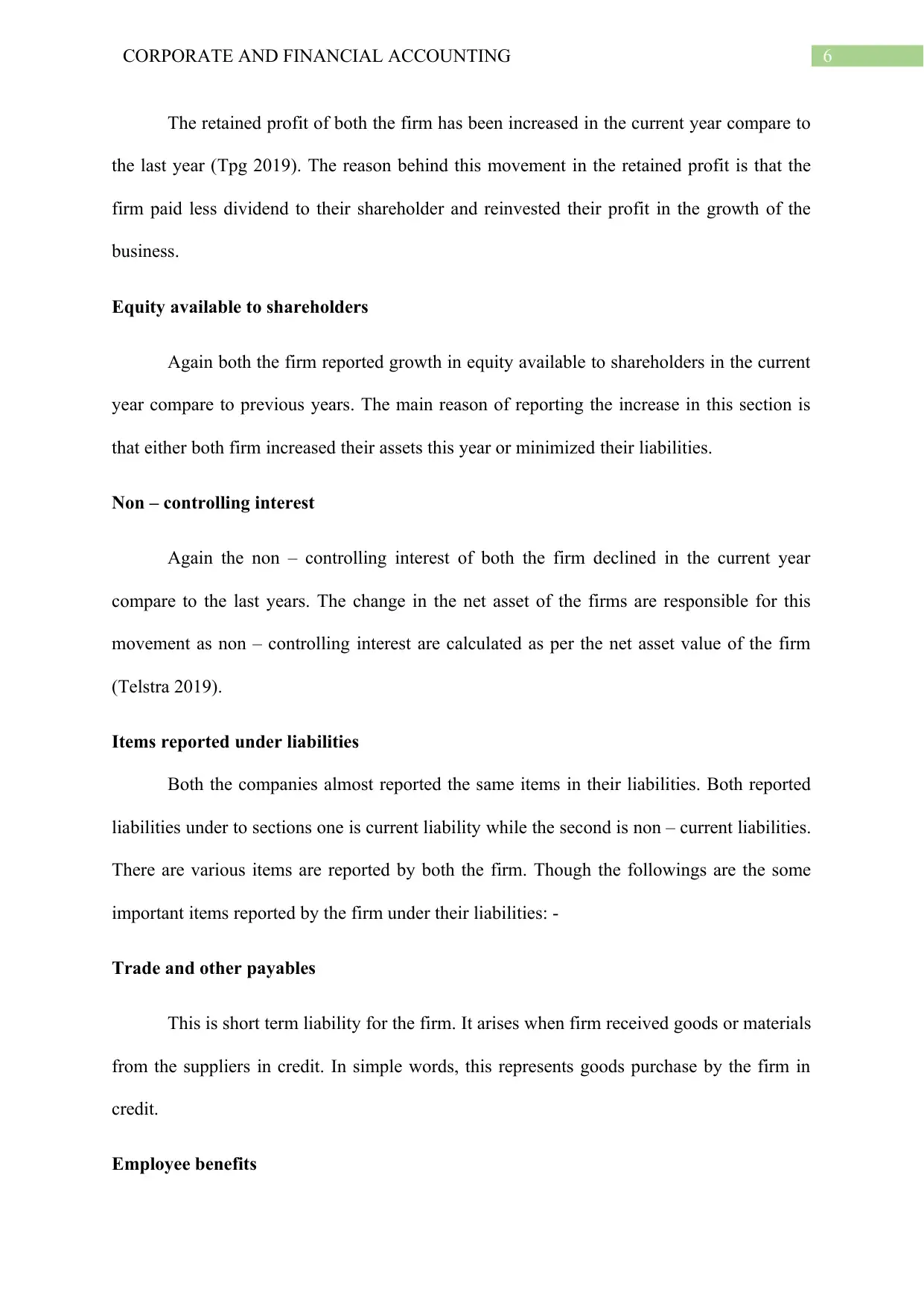
6CORPORATE AND FINANCIAL ACCOUNTING
The retained profit of both the firm has been increased in the current year compare to
the last year (Tpg 2019). The reason behind this movement in the retained profit is that the
firm paid less dividend to their shareholder and reinvested their profit in the growth of the
business.
Equity available to shareholders
Again both the firm reported growth in equity available to shareholders in the current
year compare to previous years. The main reason of reporting the increase in this section is
that either both firm increased their assets this year or minimized their liabilities.
Non – controlling interest
Again the non – controlling interest of both the firm declined in the current year
compare to the last years. The change in the net asset of the firms are responsible for this
movement as non – controlling interest are calculated as per the net asset value of the firm
(Telstra 2019).
Items reported under liabilities
Both the companies almost reported the same items in their liabilities. Both reported
liabilities under to sections one is current liability while the second is non – current liabilities.
There are various items are reported by both the firm. Though the followings are the some
important items reported by the firm under their liabilities: -
Trade and other payables
This is short term liability for the firm. It arises when firm received goods or materials
from the suppliers in credit. In simple words, this represents goods purchase by the firm in
credit.
Employee benefits
The retained profit of both the firm has been increased in the current year compare to
the last year (Tpg 2019). The reason behind this movement in the retained profit is that the
firm paid less dividend to their shareholder and reinvested their profit in the growth of the
business.
Equity available to shareholders
Again both the firm reported growth in equity available to shareholders in the current
year compare to previous years. The main reason of reporting the increase in this section is
that either both firm increased their assets this year or minimized their liabilities.
Non – controlling interest
Again the non – controlling interest of both the firm declined in the current year
compare to the last years. The change in the net asset of the firms are responsible for this
movement as non – controlling interest are calculated as per the net asset value of the firm
(Telstra 2019).
Items reported under liabilities
Both the companies almost reported the same items in their liabilities. Both reported
liabilities under to sections one is current liability while the second is non – current liabilities.
There are various items are reported by both the firm. Though the followings are the some
important items reported by the firm under their liabilities: -
Trade and other payables
This is short term liability for the firm. It arises when firm received goods or materials
from the suppliers in credit. In simple words, this represents goods purchase by the firm in
credit.
Employee benefits
Paraphrase This Document
Need a fresh take? Get an instant paraphrase of this document with our AI Paraphraser
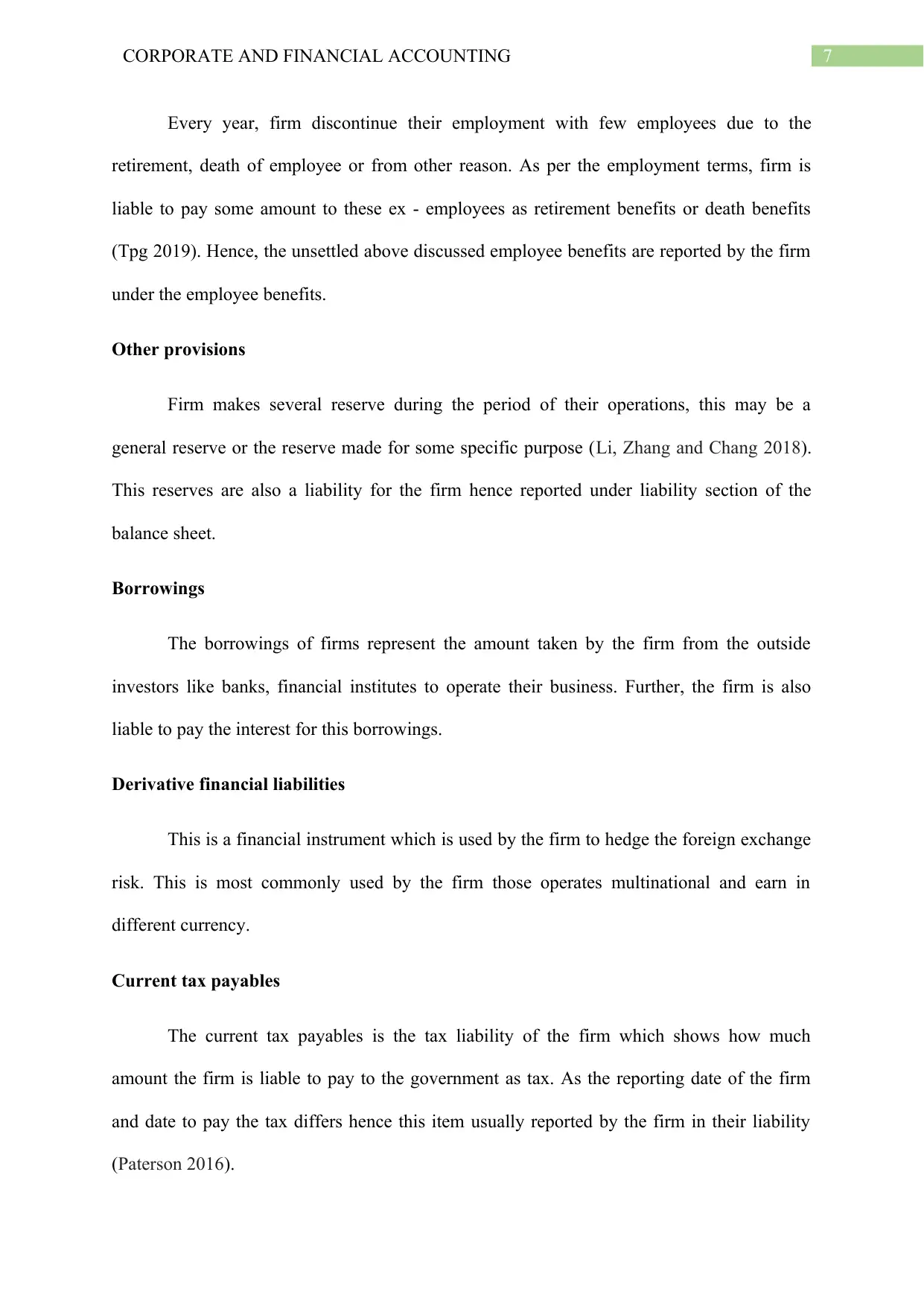
7CORPORATE AND FINANCIAL ACCOUNTING
Every year, firm discontinue their employment with few employees due to the
retirement, death of employee or from other reason. As per the employment terms, firm is
liable to pay some amount to these ex - employees as retirement benefits or death benefits
(Tpg 2019). Hence, the unsettled above discussed employee benefits are reported by the firm
under the employee benefits.
Other provisions
Firm makes several reserve during the period of their operations, this may be a
general reserve or the reserve made for some specific purpose (Li, Zhang and Chang 2018).
This reserves are also a liability for the firm hence reported under liability section of the
balance sheet.
Borrowings
The borrowings of firms represent the amount taken by the firm from the outside
investors like banks, financial institutes to operate their business. Further, the firm is also
liable to pay the interest for this borrowings.
Derivative financial liabilities
This is a financial instrument which is used by the firm to hedge the foreign exchange
risk. This is most commonly used by the firm those operates multinational and earn in
different currency.
Current tax payables
The current tax payables is the tax liability of the firm which shows how much
amount the firm is liable to pay to the government as tax. As the reporting date of the firm
and date to pay the tax differs hence this item usually reported by the firm in their liability
(Paterson 2016).
Every year, firm discontinue their employment with few employees due to the
retirement, death of employee or from other reason. As per the employment terms, firm is
liable to pay some amount to these ex - employees as retirement benefits or death benefits
(Tpg 2019). Hence, the unsettled above discussed employee benefits are reported by the firm
under the employee benefits.
Other provisions
Firm makes several reserve during the period of their operations, this may be a
general reserve or the reserve made for some specific purpose (Li, Zhang and Chang 2018).
This reserves are also a liability for the firm hence reported under liability section of the
balance sheet.
Borrowings
The borrowings of firms represent the amount taken by the firm from the outside
investors like banks, financial institutes to operate their business. Further, the firm is also
liable to pay the interest for this borrowings.
Derivative financial liabilities
This is a financial instrument which is used by the firm to hedge the foreign exchange
risk. This is most commonly used by the firm those operates multinational and earn in
different currency.
Current tax payables
The current tax payables is the tax liability of the firm which shows how much
amount the firm is liable to pay to the government as tax. As the reporting date of the firm
and date to pay the tax differs hence this item usually reported by the firm in their liability
(Paterson 2016).
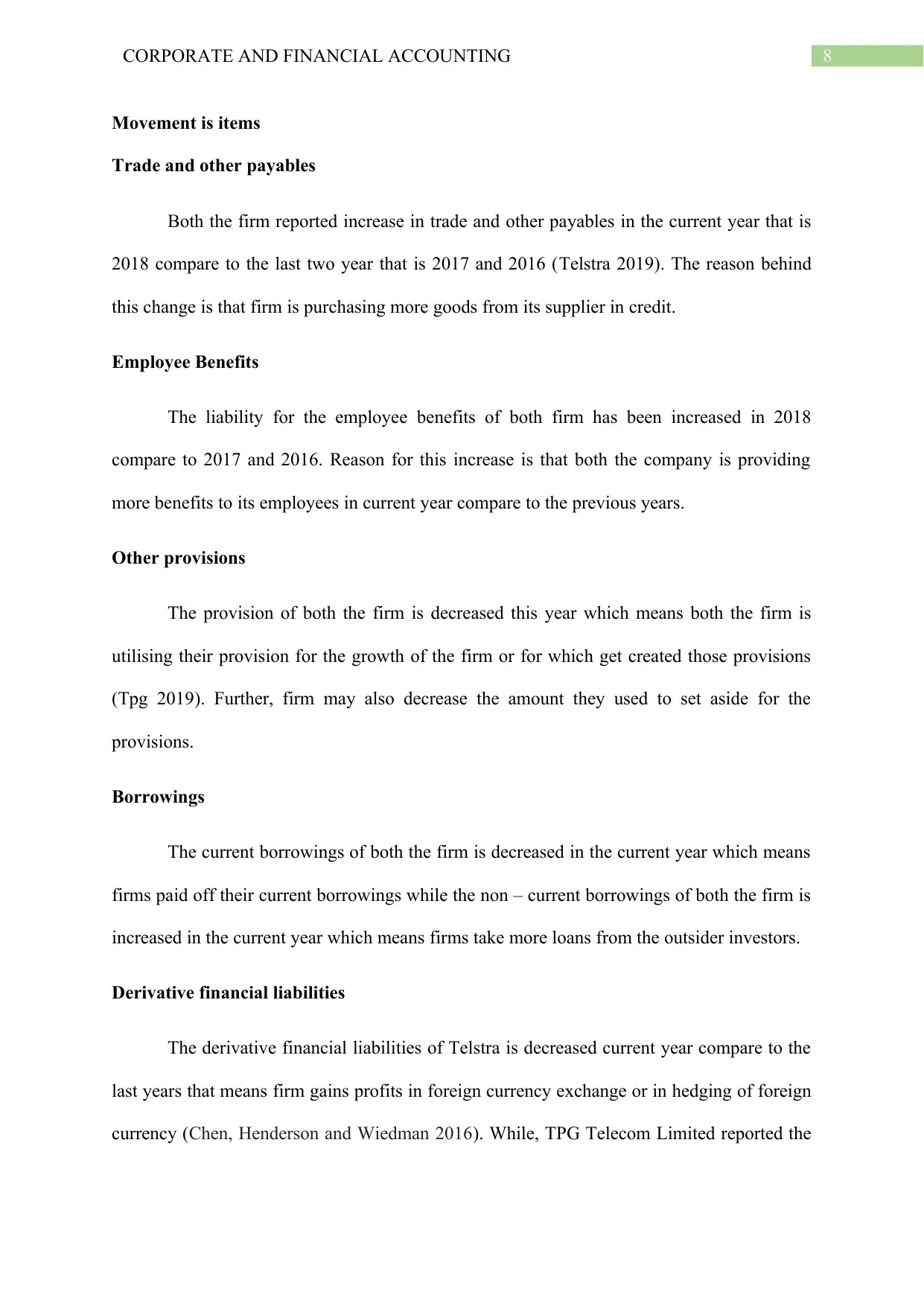
8CORPORATE AND FINANCIAL ACCOUNTING
Movement is items
Trade and other payables
Both the firm reported increase in trade and other payables in the current year that is
2018 compare to the last two year that is 2017 and 2016 (Telstra 2019). The reason behind
this change is that firm is purchasing more goods from its supplier in credit.
Employee Benefits
The liability for the employee benefits of both firm has been increased in 2018
compare to 2017 and 2016. Reason for this increase is that both the company is providing
more benefits to its employees in current year compare to the previous years.
Other provisions
The provision of both the firm is decreased this year which means both the firm is
utilising their provision for the growth of the firm or for which get created those provisions
(Tpg 2019). Further, firm may also decrease the amount they used to set aside for the
provisions.
Borrowings
The current borrowings of both the firm is decreased in the current year which means
firms paid off their current borrowings while the non – current borrowings of both the firm is
increased in the current year which means firms take more loans from the outsider investors.
Derivative financial liabilities
The derivative financial liabilities of Telstra is decreased current year compare to the
last years that means firm gains profits in foreign currency exchange or in hedging of foreign
currency (Chen, Henderson and Wiedman 2016). While, TPG Telecom Limited reported the
Movement is items
Trade and other payables
Both the firm reported increase in trade and other payables in the current year that is
2018 compare to the last two year that is 2017 and 2016 (Telstra 2019). The reason behind
this change is that firm is purchasing more goods from its supplier in credit.
Employee Benefits
The liability for the employee benefits of both firm has been increased in 2018
compare to 2017 and 2016. Reason for this increase is that both the company is providing
more benefits to its employees in current year compare to the previous years.
Other provisions
The provision of both the firm is decreased this year which means both the firm is
utilising their provision for the growth of the firm or for which get created those provisions
(Tpg 2019). Further, firm may also decrease the amount they used to set aside for the
provisions.
Borrowings
The current borrowings of both the firm is decreased in the current year which means
firms paid off their current borrowings while the non – current borrowings of both the firm is
increased in the current year which means firms take more loans from the outsider investors.
Derivative financial liabilities
The derivative financial liabilities of Telstra is decreased current year compare to the
last years that means firm gains profits in foreign currency exchange or in hedging of foreign
currency (Chen, Henderson and Wiedman 2016). While, TPG Telecom Limited reported the
⊘ This is a preview!⊘
Do you want full access?
Subscribe today to unlock all pages.

Trusted by 1+ million students worldwide
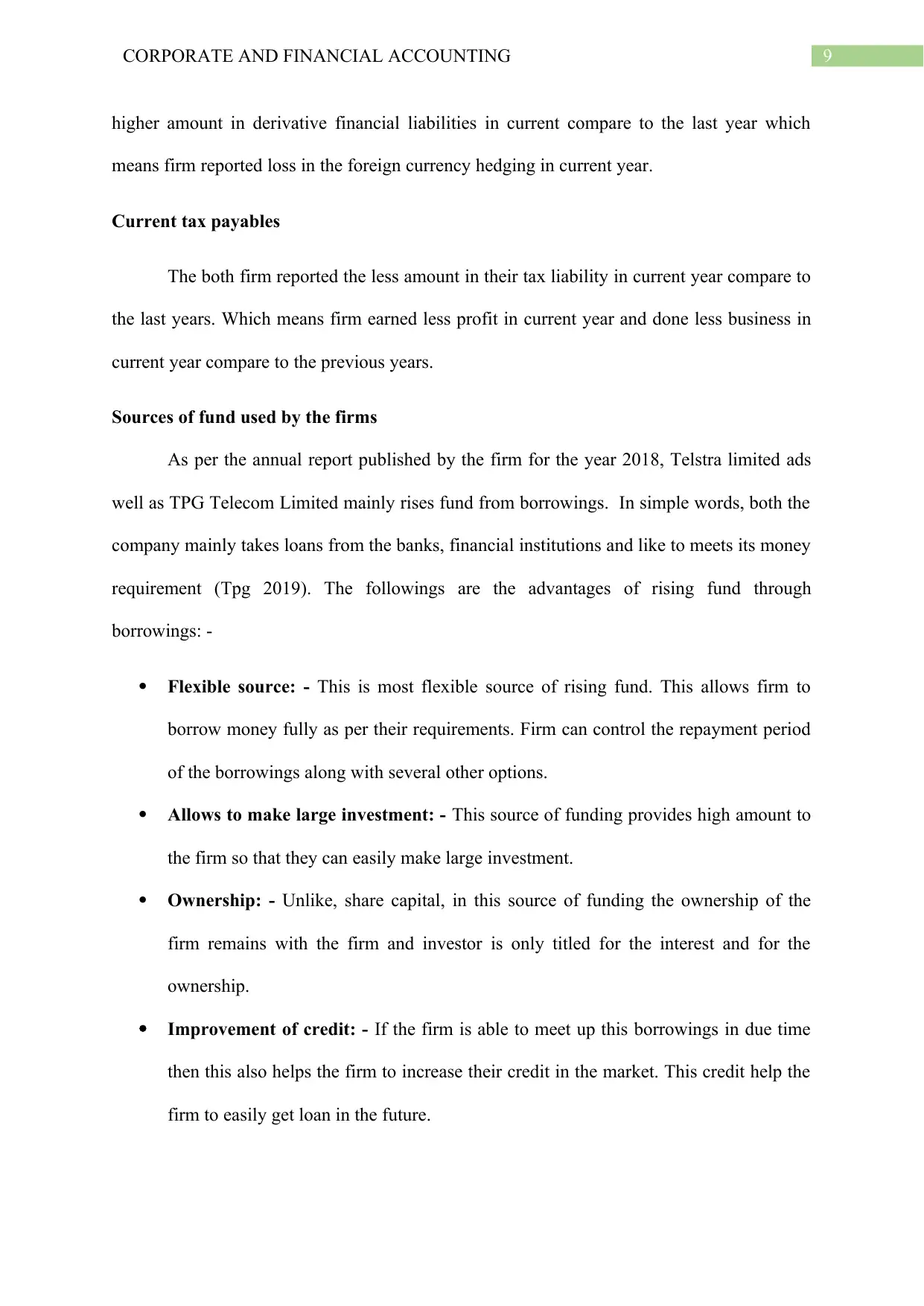
9CORPORATE AND FINANCIAL ACCOUNTING
higher amount in derivative financial liabilities in current compare to the last year which
means firm reported loss in the foreign currency hedging in current year.
Current tax payables
The both firm reported the less amount in their tax liability in current year compare to
the last years. Which means firm earned less profit in current year and done less business in
current year compare to the previous years.
Sources of fund used by the firms
As per the annual report published by the firm for the year 2018, Telstra limited ads
well as TPG Telecom Limited mainly rises fund from borrowings. In simple words, both the
company mainly takes loans from the banks, financial institutions and like to meets its money
requirement (Tpg 2019). The followings are the advantages of rising fund through
borrowings: -
Flexible source: - This is most flexible source of rising fund. This allows firm to
borrow money fully as per their requirements. Firm can control the repayment period
of the borrowings along with several other options.
Allows to make large investment: - This source of funding provides high amount to
the firm so that they can easily make large investment.
Ownership: - Unlike, share capital, in this source of funding the ownership of the
firm remains with the firm and investor is only titled for the interest and for the
ownership.
Improvement of credit: - If the firm is able to meet up this borrowings in due time
then this also helps the firm to increase their credit in the market. This credit help the
firm to easily get loan in the future.
higher amount in derivative financial liabilities in current compare to the last year which
means firm reported loss in the foreign currency hedging in current year.
Current tax payables
The both firm reported the less amount in their tax liability in current year compare to
the last years. Which means firm earned less profit in current year and done less business in
current year compare to the previous years.
Sources of fund used by the firms
As per the annual report published by the firm for the year 2018, Telstra limited ads
well as TPG Telecom Limited mainly rises fund from borrowings. In simple words, both the
company mainly takes loans from the banks, financial institutions and like to meets its money
requirement (Tpg 2019). The followings are the advantages of rising fund through
borrowings: -
Flexible source: - This is most flexible source of rising fund. This allows firm to
borrow money fully as per their requirements. Firm can control the repayment period
of the borrowings along with several other options.
Allows to make large investment: - This source of funding provides high amount to
the firm so that they can easily make large investment.
Ownership: - Unlike, share capital, in this source of funding the ownership of the
firm remains with the firm and investor is only titled for the interest and for the
ownership.
Improvement of credit: - If the firm is able to meet up this borrowings in due time
then this also helps the firm to increase their credit in the market. This credit help the
firm to easily get loan in the future.
Paraphrase This Document
Need a fresh take? Get an instant paraphrase of this document with our AI Paraphraser
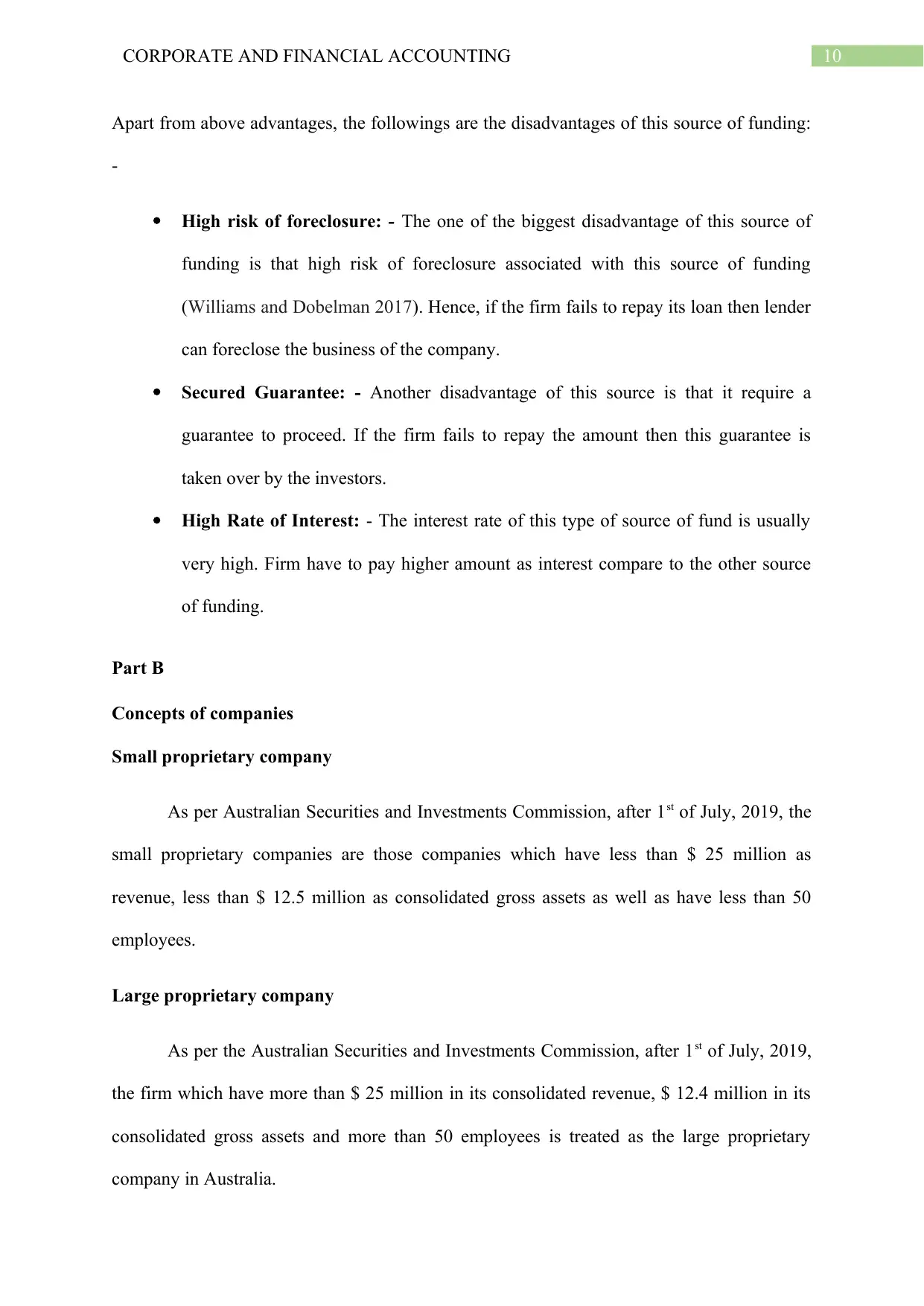
10CORPORATE AND FINANCIAL ACCOUNTING
Apart from above advantages, the followings are the disadvantages of this source of funding:
-
High risk of foreclosure: - The one of the biggest disadvantage of this source of
funding is that high risk of foreclosure associated with this source of funding
(Williams and Dobelman 2017). Hence, if the firm fails to repay its loan then lender
can foreclose the business of the company.
Secured Guarantee: - Another disadvantage of this source is that it require a
guarantee to proceed. If the firm fails to repay the amount then this guarantee is
taken over by the investors.
High Rate of Interest: - The interest rate of this type of source of fund is usually
very high. Firm have to pay higher amount as interest compare to the other source
of funding.
Part B
Concepts of companies
Small proprietary company
As per Australian Securities and Investments Commission, after 1st of July, 2019, the
small proprietary companies are those companies which have less than $ 25 million as
revenue, less than $ 12.5 million as consolidated gross assets as well as have less than 50
employees.
Large proprietary company
As per the Australian Securities and Investments Commission, after 1st of July, 2019,
the firm which have more than $ 25 million in its consolidated revenue, $ 12.4 million in its
consolidated gross assets and more than 50 employees is treated as the large proprietary
company in Australia.
Apart from above advantages, the followings are the disadvantages of this source of funding:
-
High risk of foreclosure: - The one of the biggest disadvantage of this source of
funding is that high risk of foreclosure associated with this source of funding
(Williams and Dobelman 2017). Hence, if the firm fails to repay its loan then lender
can foreclose the business of the company.
Secured Guarantee: - Another disadvantage of this source is that it require a
guarantee to proceed. If the firm fails to repay the amount then this guarantee is
taken over by the investors.
High Rate of Interest: - The interest rate of this type of source of fund is usually
very high. Firm have to pay higher amount as interest compare to the other source
of funding.
Part B
Concepts of companies
Small proprietary company
As per Australian Securities and Investments Commission, after 1st of July, 2019, the
small proprietary companies are those companies which have less than $ 25 million as
revenue, less than $ 12.5 million as consolidated gross assets as well as have less than 50
employees.
Large proprietary company
As per the Australian Securities and Investments Commission, after 1st of July, 2019,
the firm which have more than $ 25 million in its consolidated revenue, $ 12.4 million in its
consolidated gross assets and more than 50 employees is treated as the large proprietary
company in Australia.
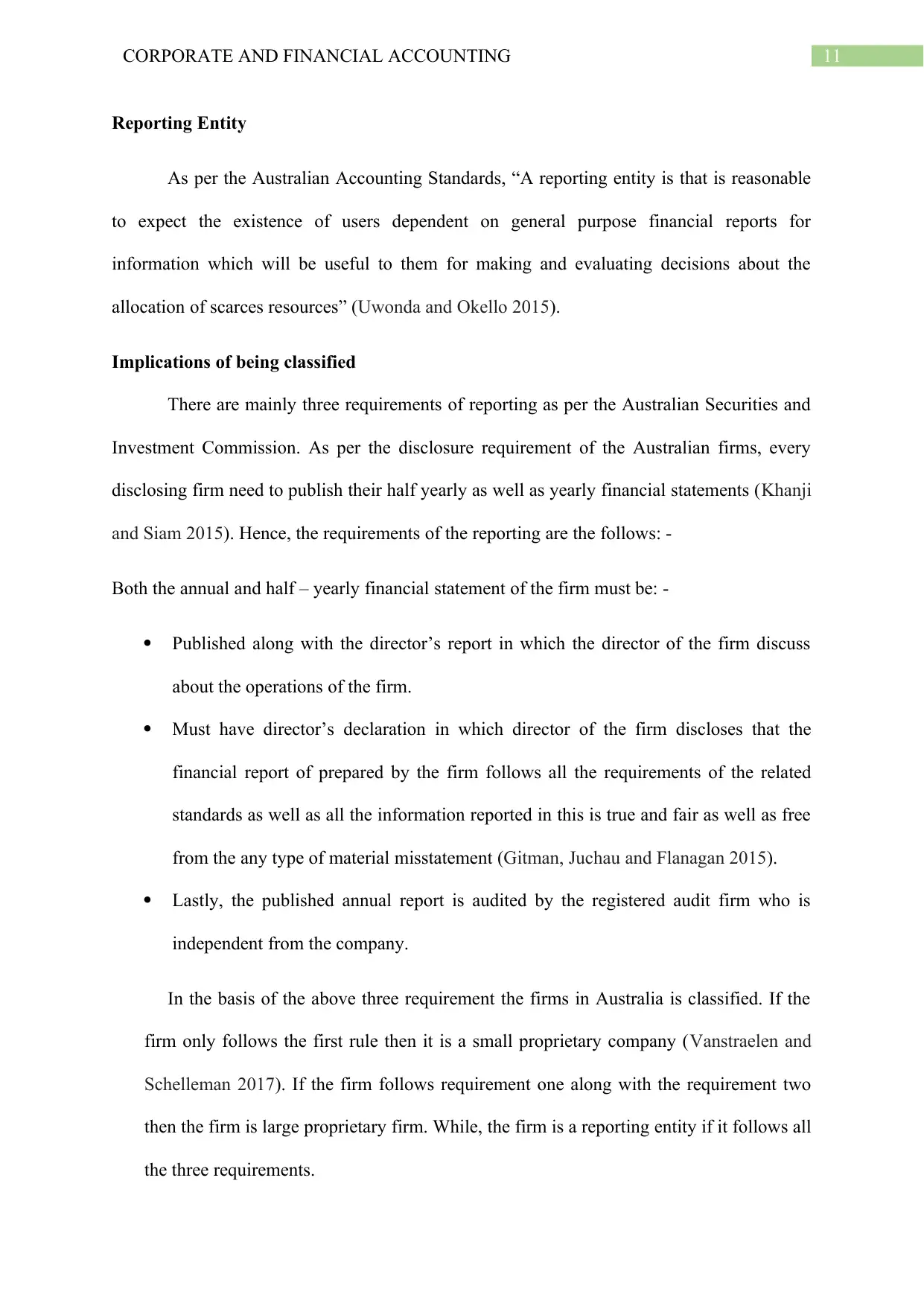
11CORPORATE AND FINANCIAL ACCOUNTING
Reporting Entity
As per the Australian Accounting Standards, “A reporting entity is that is reasonable
to expect the existence of users dependent on general purpose financial reports for
information which will be useful to them for making and evaluating decisions about the
allocation of scarces resources” (Uwonda and Okello 2015).
Implications of being classified
There are mainly three requirements of reporting as per the Australian Securities and
Investment Commission. As per the disclosure requirement of the Australian firms, every
disclosing firm need to publish their half yearly as well as yearly financial statements (Khanji
and Siam 2015). Hence, the requirements of the reporting are the follows: -
Both the annual and half – yearly financial statement of the firm must be: -
Published along with the director’s report in which the director of the firm discuss
about the operations of the firm.
Must have director’s declaration in which director of the firm discloses that the
financial report of prepared by the firm follows all the requirements of the related
standards as well as all the information reported in this is true and fair as well as free
from the any type of material misstatement (Gitman, Juchau and Flanagan 2015).
Lastly, the published annual report is audited by the registered audit firm who is
independent from the company.
In the basis of the above three requirement the firms in Australia is classified. If the
firm only follows the first rule then it is a small proprietary company (Vanstraelen and
Schelleman 2017). If the firm follows requirement one along with the requirement two
then the firm is large proprietary firm. While, the firm is a reporting entity if it follows all
the three requirements.
Reporting Entity
As per the Australian Accounting Standards, “A reporting entity is that is reasonable
to expect the existence of users dependent on general purpose financial reports for
information which will be useful to them for making and evaluating decisions about the
allocation of scarces resources” (Uwonda and Okello 2015).
Implications of being classified
There are mainly three requirements of reporting as per the Australian Securities and
Investment Commission. As per the disclosure requirement of the Australian firms, every
disclosing firm need to publish their half yearly as well as yearly financial statements (Khanji
and Siam 2015). Hence, the requirements of the reporting are the follows: -
Both the annual and half – yearly financial statement of the firm must be: -
Published along with the director’s report in which the director of the firm discuss
about the operations of the firm.
Must have director’s declaration in which director of the firm discloses that the
financial report of prepared by the firm follows all the requirements of the related
standards as well as all the information reported in this is true and fair as well as free
from the any type of material misstatement (Gitman, Juchau and Flanagan 2015).
Lastly, the published annual report is audited by the registered audit firm who is
independent from the company.
In the basis of the above three requirement the firms in Australia is classified. If the
firm only follows the first rule then it is a small proprietary company (Vanstraelen and
Schelleman 2017). If the firm follows requirement one along with the requirement two
then the firm is large proprietary firm. While, the firm is a reporting entity if it follows all
the three requirements.
⊘ This is a preview!⊘
Do you want full access?
Subscribe today to unlock all pages.

Trusted by 1+ million students worldwide
1 out of 16
Related Documents
Your All-in-One AI-Powered Toolkit for Academic Success.
+13062052269
info@desklib.com
Available 24*7 on WhatsApp / Email
![[object Object]](/_next/static/media/star-bottom.7253800d.svg)
Unlock your academic potential
Copyright © 2020–2025 A2Z Services. All Rights Reserved. Developed and managed by ZUCOL.




